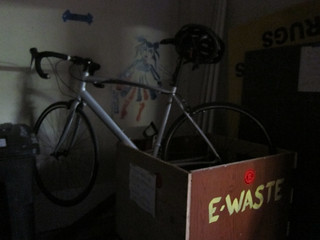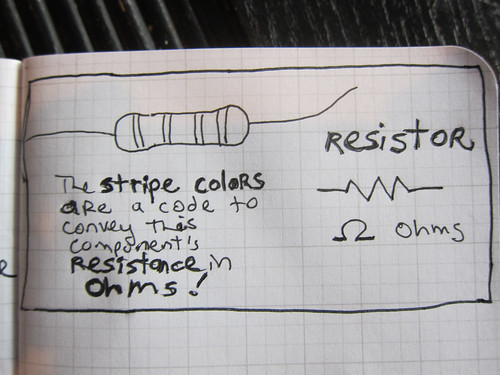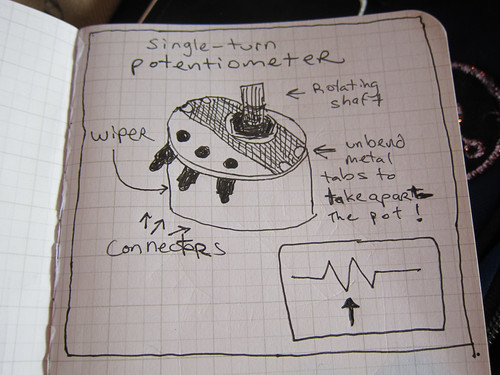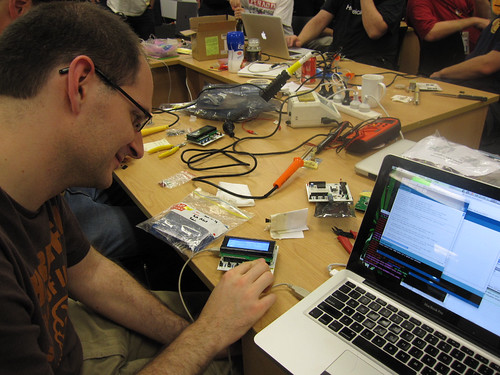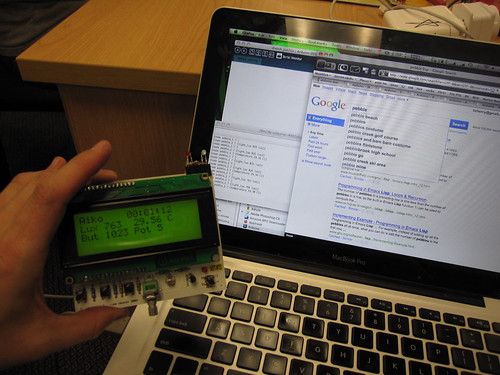I’ve been helping out lately at Noisebridge during Circuit Hacking Monday. One week, some people showed up expecting the event and no one was there to run it, so I ran it for someone I knew from She’s Geeky, her friend and teenagers, and a couple of extra adults who were here from Norway and Denmark for Google I/O. I had just been pawing through the soldering supplies, organizing them a bit as I searched for what I needed for my project (messing around with a LilyPad Arduino), and had found a little bag of cheap LED light up badges shaped like teddy bears. So we used those tiny kits to make blinking badges. It was chaotic, but fun.
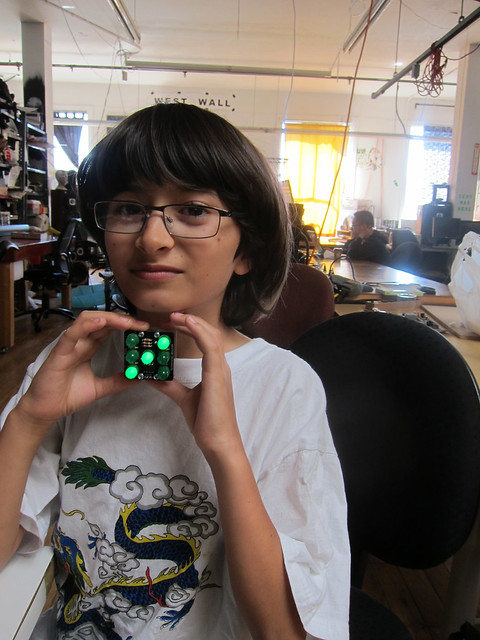
I talked with Mitch Altman to find out where his kits for sale were and if it was okay for me to sell them while he’s out of town, and then send him the money. I might, though, just order some kits as cheaply as I can find them, and keep them independently to avoid hassle. As I end up giving tours to lots of new people, many of them from out of town or overseas, I could do them a favor by giving them something geeky to do in the space rather than sit and check their email!
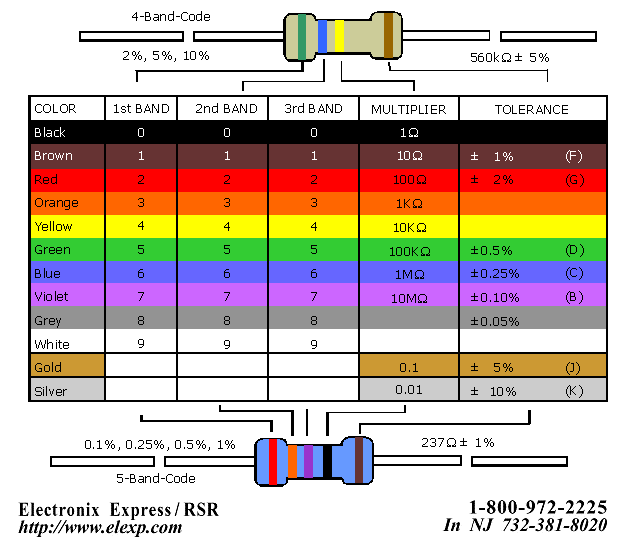
The next week things were back to normal as Miloh and Rolf were at Noisebridge to run the class. Before they showed up, a teenage volunteer helped me set up soldering stations. More and more people kept coming in so the situation got quite chaotic again as we were giving them tours of the space and trying to find room. I realized that next time I would approach things differently — clearing the whole area of people who were working, and setting up 20 or more stations ahead of time, so that we weren’t doing setup and giving tours at the same time.
During the event Miloh and Rolf really took over the teaching aspect. I was somewhat trapped with my scooter in a corner because of the number of people, the table arrangement, the many chairs and the backpacks all over the floor. So I also would like to look at making the central area of Noisebridge less cluttered with tables, chairs, and stuff for the future so that I can participate. In my corner, I again hung with some kids and the teenage volunteer, and a guy who couldn’t hear well. The kid didn’t have a computer to look at the instructions for his kit, and needed a lot of one on one help as he was maybe a bit non neurotypical. The guy who hung out with us could not hear well in a situation with background noise. I’m in the same boat — I’m in my 40s and just can’t hear in a loud, chaotic situation. The kid fixed his Mintyboost and then made a tv-b-gone. The other guy made a blinky badge then was hooked and got one of those big name LED badges, I think. He appreciated the How to Solder comic book print out that I happened to have on me because he missed all of Miloh and Rolf’s explanations. I thought it was interesting that, marked out as somewhat different and disabled, I ended up doing more one on one work with people who had particular access needs.
Our volunteer also was super helpful in that capacity and seemed unusually alert to access issues, like that chairs or cables were in the way of my scooter or that it might be hard for me to get up to get supplies on high shelves. After the event when his dad came to pick him up I saw that his dad had one arm and walked with a cane. So growing up with a parent who has some mobility issues he might be more tuned in than others usually are.
I thought both those things were interesting! And figured it is a pretty good role for me at CHM. If you have particular access needs or are going to bring a bunch of 10 year olds to Circuit Hacking Monday (Mondays at 7:30pm) then feel free to email me with questions and see if I can be there & be helpful: lizhenry@gmail.com.
Basic supplies are running low. We have lots of soldering irons, including a bunch that I think Jake, Lilia, and MC Hawking won in a contest, but they’ve seen very heavy use over the last couple of years. So there are a lot of kind of crappy soldering irons and a few decent ones. We might be able to clean them or swap the tips cheaply. We have lots of snippers and wirestrippers. We need solder, weighted holders with alligator clips and lenses, more of those weighted bases with copper wool for cleaning soldering iron tips, and more de-soldering braid. Plus it would be so nice to have a supply of many kinds of coin cell batteries. After I talked with Miloh about that he shared a giant complicated spreadsheet with me. I haven’t read through it yet! But it would be great to get particular donations for restocking our electronics supplies.
We have shelves and shelves of hardware junk, in bins, and a wall of tiny little parts in tiny drawers meticulously labelled!

Yesterday I spent some nice time in the afternoon doing a Dice Kit with my son. We couldn’t find any decent epoxy or glue, so went to the fabric store on the corner, but ended up getting a big tube of contact cement from the dollar store. I gave a lot of tours and hung out with my friend who came by to fix her headphone wires. We’re both going to help TA at Black Girls Code in San Francisco. She ended up also using the wood shop for another project – modifying wooden artists’ brush handles to make those long tapered sticks so useful for holding up long hair and especially dreadlocks. Claudia aka Geekgirl showed up too and told me about how she is going to Rwanda in September and has a job there teaching IT and computer programming to middle school girls. Nifty! Meanwhile, my son played with MC Hawking and read comic books in the library after he was done with the Dice Kit. Along the way he learned to figure out the values of resistors from the color code chart (and learned it is not hard to just memorize the numbers.) We looked at my LilyPad and he got to the point of comfort with the code to make a scale go up and down again and modify the time of the notes. I gave the world’s worst and briefest explanation of what a function is and what it means to pass it variables, but he caught on with no effort. I’m very spoiled as a teacher when I set out teach him anything! He gets the idea too quickly!
Anyway, I sat up far too long that afternoon, and sadly had to leave before Replicator Wednesday kicked off. It has been nice going out into the world a bit more, this last month, more than just for the grocery store and physical therapy.
One last note: this is what happens if you leave your bike blocking the elevator at Noisebridge!!! It gets put into the E-WASTE bin!
